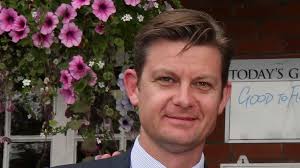Where’s that Bloody Strategy? BHA Leadership Keeps Circling the Paddock
Brant Dunshea, the BHA’s freshly minted acting CEO, has diplomatically praised outgoing chief executive Julie Harrington for her “great leadership” and efforts to place the sport on “a strong footing.”
Ed Grimshaw
12/4/20244 min read


Brant Dunshea, the BHA’s freshly minted acting CEO, has diplomatically praised outgoing chief executive Julie Harrington for her “great leadership” and efforts to place the sport on “a strong footing.” It’s the kind of praise so polite and perfunctory it might as well have been handwritten on a complimentary thank-you card from a country house hotel. Yet for all the effusive nods to “significant reforms” and the elusive promise of a “single collective strategy,” one can’t help but wonder: where is this bloody strategy, and why does it still feel like a riddle wrapped in a press release? I have found Brant polite, helpful and willing to listen but this gig would test anyone, lets hope he is listening to owners and punters not just the racecourse directors.
A Polite Farewell or a Veiled Admission of Failure?
Dunshea’s remarks about Harrington navigating the BHA “out of Covid” were doubtlessly well-intentioned, but they carry the air of a half-hearted eulogy for a job half-done. Yes, the pandemic was a uniquely challenging time for the sport. Keeping the show on the road deserves credit. But the much-touted “collective strategy” that was meant to unify British racing still feels as mythical as a unicorn trotting down the finishing straight at Cheltenham.
The reality is that Harrington’s time at the helm was marked by noble aspirations that rarely crossed the finish line. The vision of bringing together warring factions—racecourses, trainers, owners, and a public increasingly queasy about animal welfare issues—remains as fractured as ever. Harrington’s leadership was polite, procedural, and often pragmatic, but the absence of transformative breakthroughs leaves a lingering sense of what might have been.
Dunshea’s decision to tread lightly in his comments may reflect British racing’s culture of genteel politeness, but it also risks perpetuating a leadership style that prioritises decorum over dynamism. And if this is how things are going to be managed under his tenure, we’re off to a decidedly bad start.
The Perils of Passing the Buck
The lack of a permanent CEO adds a troubling layer to this already muddled picture. The decision to delay appointing Harrington’s successor until Lord Allen, the incoming BHA chair, can play an active role in the process is being spun as prudent timing. Yet this delay raises an obvious question: if Lord Allen’s involvement is so critical, why wasn’t the process aligned with his arrival in the first place?
It feels more like an excuse than a strategy, a convenient way to kick the can down the track while pretending it’s all part of a master plan. Meanwhile, Dunshea is left holding the reins with an agenda that, at best, looks like business as usual and, at worst, reeks of inertia. If this limbo period stretches on, British racing risks squandering what little momentum it has left.
British Racing’s Spluttering Engine
The BHA’s problems aren’t limited to its leadership musical chairs. The sport faces an existential crisis as falling attendance, declining public interest, and escalating criticism from animal welfare groups chip away at its foundations. The much-vaunted “single collective strategy” was meant to address these issues head-on. Instead, it’s become a catchphrase trotted out at every opportunity, conspicuously absent from the winner’s enclosure.
Even when reforms are implemented, they often feel piecemeal and reactive. Racing’s big players—trainers, owners, and racecourse operators—seem more interested in defending their own turf than working toward a common goal. Without a strong, unifying leader, the BHA risks becoming little more than a referee in a never-ending squabble over prize money and welfare standards.
Dunshea’s Moment to Seize or Squander
As acting CEO, Dunshea now has the unenviable task of keeping the sport on track while the BHA dithers over its long-term leadership. His career trajectory within the BHA suggests he’s capable, but capability isn’t enough. What British racing needs now is boldness, not just competence. Dunshea must prove he’s willing to ruffle feathers and make hard decisions, even if that means stepping on a few aristocratic toes.
But if his tribute to Harrington is anything to go by, we might be in for more of the same polite, procedural leadership that got us into this mess in the first place. If the BHA continues to avoid direct confrontation with the sport’s deeper issues, Dunshea’s tenure—temporary though it may be—will feel like yet another lap around the paddock, with no clear winner in sight.
Leadership Without Direction: A Dangerous Gamble
The sport of kings is beginning to feel more like the sport of endless committees and deferred decisions. Harrington’s legacy, Lord Allen’s impending arrival, and Dunshea’s temporary stewardship are all being framed as necessary steps in a long-term plan. But for those on the ground—punters, trainers, and the dwindling crowds at the racecourse—it all feels maddeningly abstract.
Where is the bloody strategy? Where is the vision? Where is the decisive leadership that British racing so desperately needs?
Until the BHA stops dancing around these questions and starts delivering real answers, the sport will remain stuck in the stalls, while its competitors sprint ahead into a future where relevance and sustainability actually mean something. Dunshea’s diplomatic tribute to Harrington might have been polite, but unless he’s prepared to break with tradition and inject some urgency into the BHA, we’re looking at more of the same: polite words, lofty promises, and precious little action.
